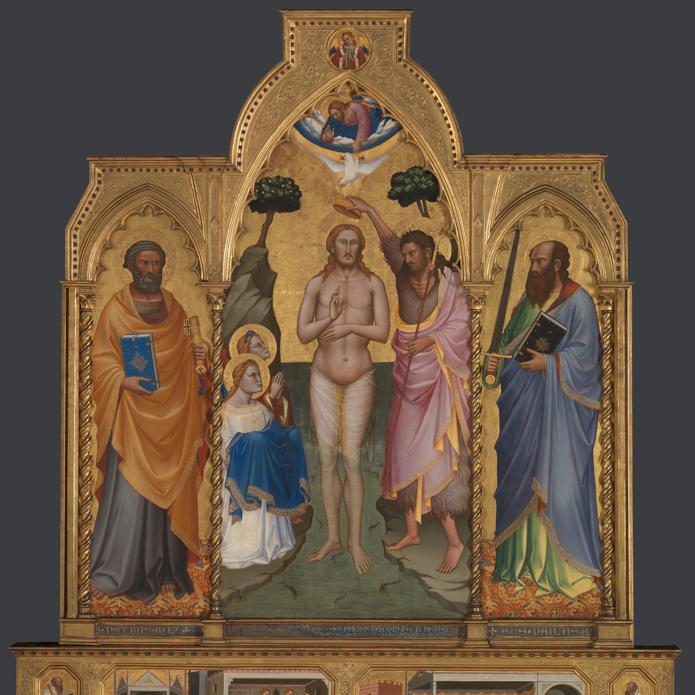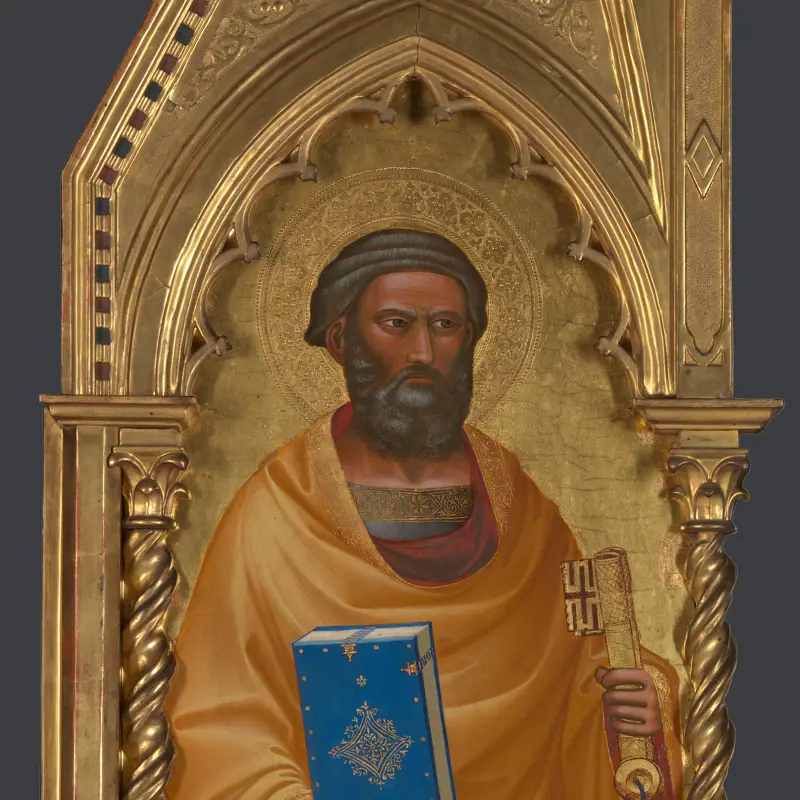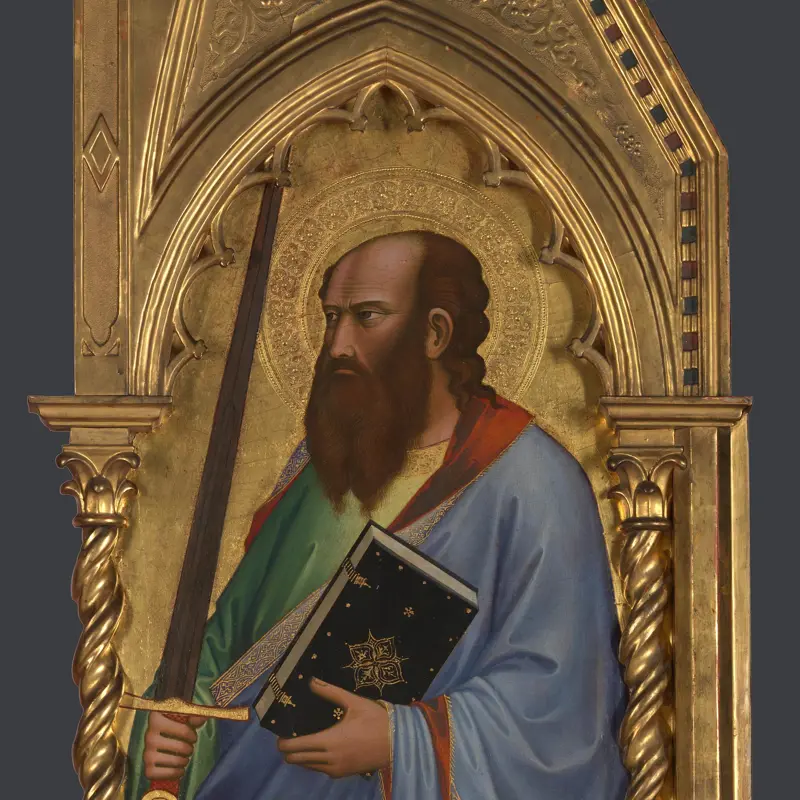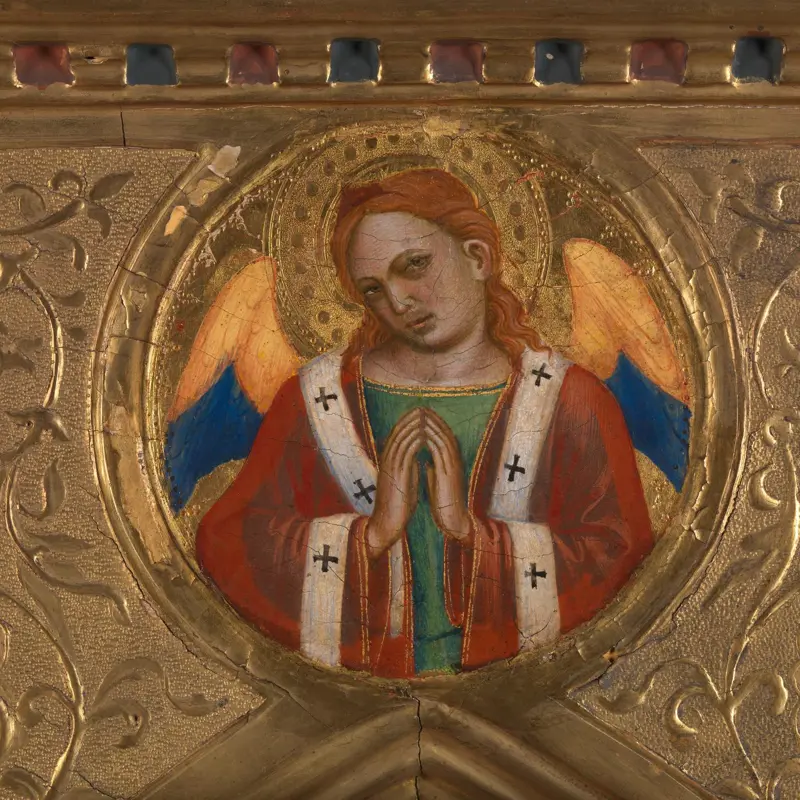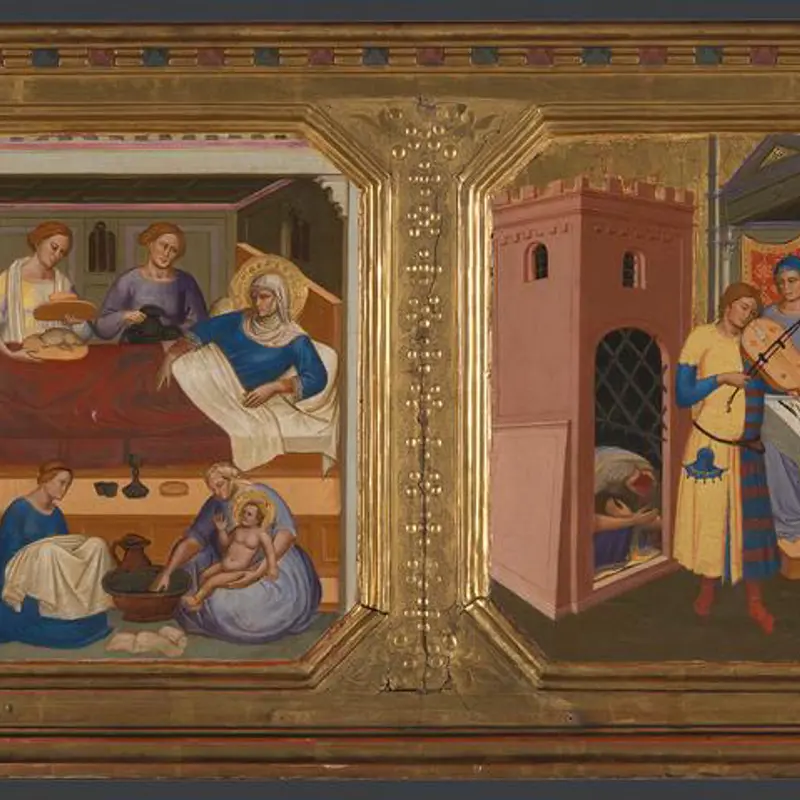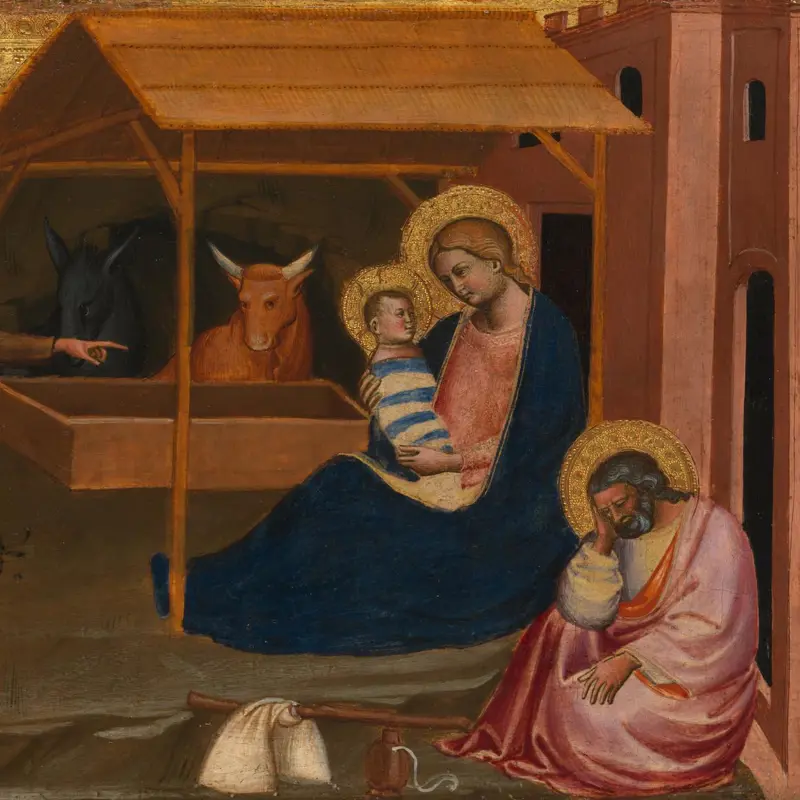Niccolò di Pietro Gerini, 'The Baptism of Christ: Main Tier Central Panel', 1387
About the work
Overview
It is rare to see images of the baptism of Christ at the centre of altarpieces and this is quite possibly the first example where it takes this position in Italian painting.
Christ stands in the centre of the river Jordan, naked but for a transparent loin cloth. He gazes directly at us, making a blessing gesture with the fingers of his right hand. The ease and stillness of Christ’s pose reinforces his majesty and authority in the centre of a scene full of movement. Saint John the Baptist reaches up on to his tiptoes to baptise him, pouring the river water over his head from a wooden bowl.
In the sky above, God the Father appears in the clouds, dispatching the Holy Ghost in the form of a dove towards Christ. Two angels on the left river bank look on – one holds a blue cloth with a gilded edge, ready to dry Christ.
Key facts
Details
- Full title
- The Baptism of Christ: Main Tier Central Panel
- Artist
- Niccolò di Pietro Gerini
- Artist dates
- Documented 1368, died probably 1415, certainly by 1427
- Part of the group
- Baptism Altarpiece
- Date made
- 1387
- Medium and support
- Egg tempera on wood (probably poplar)
- Dimensions
- 160 × 76 cm
- Inscription summary
- Signed; Dated and inscribed
- Acquisition credit
- Bought, 1857
- Inventory number
- NG579.1
- Location
- Not on display
- Collection
- Main Collection
Provenance
Additional information
Text extracted from the ‘Provenance’ section of the catalogue entry in Dillian Gordon, ‘National Gallery Catalogues: The Italian Paintings before 1400’, London 2011; for further information, see the full catalogue entry.
Exhibition history
-
2011Devotion by Design: Italian Altarpieces before 1500The National Gallery (London)6 July 2011 - 2 October 2011
Bibliography
-
1864J.A. Crowe and G.B. Cavalcaselle, A New History of Painting in Italy: From the Second to the Sixteenth Century, 3 vols, London 1864
-
1901P. Schubring, 'Die primitiven Italiener im Louvre', Zeitschrift für Christliche Kunst, XIV, 1901, pp. 352-82
-
1904O. Sirén, 'Di alcuni pittori fiorentini', L'arte, VIII, 1904
-
1908O. Sirén, Giottino und seine Stellung in der gleichzeitigen florentinischen Malerei, Leipzig 1908
-
1914B. Khvoshinsky and M. Salmi, I pittori toscani dal XIII al XVI secolo: I fiorentini del Trecento, Rome 1914
-
1920O. Sirén, 'Niccolò di Pietro Gerini', in U. Thieme and F. Becker (eds), Allgemeines Lexikon der bildenden Künstler von der Antike bis zur Gegenwart, Leipzig 1920, vol. 13
-
1923R. van Marle, The Development of the Italian Schools of Painting, 19 vols, The Hague 1923
-
1927R. Offner, Studies in Florentine Painting: The Fourteenth Century, New York 1927
-
1930R. Offner and K. Steinweg, A Critical and Historical Corpus of Florentine Painting, 8 vols, New York 1930
-
1951Davies, Martin, National Gallery Catalogues: The Earlier Italian Schools, London 1951
-
1956W. Cohn, 'Notizie storiche intorno ad alcune tavole fiorentine del '300 e '400', Rivista d'arte, XXXI, 1956, pp. 66-7
-
1961M. Davies, The Earlier Italian Schools, 2nd edn, London 1961
-
1975M. Boskovits, Pittura fiorentina alla vigilia del Rinascimento, 1370-1400, Florence 1975
-
1981M.A. Lavin, Piero Della Francesca's Baptism of Christ, New York 1981
-
1986Davies, Martin, National Gallery Catalogues: The Earlier Italian Schools, revised edn, London 1986
-
1986E. Castelnuovo (ed.), La pittura in Italia: Il Duecento e il Trecento, Milan 1986
-
1987B. Cole, Italian Art 1250-1550: The Relation of Renaissance Art to Life and Society, New York 1987
-
1988Gordon, Dillian, National Gallery Catalogues: The Early Italian Schools before 1400, revised edn, London 1988
-
1991J. Dunkerton et al., Giotto to Dürer: Early Renaissance Painting in the National Gallery, New Haven 1991
-
1994E.S. Skaug, Punch Marks from Giotto to Fra Angelico: Attribution, Chronology and Workshop Relationships in Tuscan Panel Painting, With Particular Consideration to Florence c.1330-1430, Oslo 1994
-
1994A. Thomas, An Illustrated Dictionary of Narrative Painting, London 1994
-
2001
C. Baker and T. Henry, The National Gallery: Complete Illustrated Catalogue, London 2001
-
2011Gordon, Dillian, National Gallery Catalogues: The Italian Paintings before 1400, London 2011
About this record
If you know more about this work or have spotted an error, please contact us. Please note that exhibition histories are listed from 2009 onwards. Bibliographies may not be complete; more comprehensive information is available in the National Gallery Library.
Images
About the group: Baptism Altarpiece
Overview
This altarpiece is the earliest known example that shows the baptism of Christ as the central image – in large multi-panelled altarpieces it was usually the Virgin and Child.
It was made for a chapel in Santa Maria degli Angeli, the Camaldolese monastery in Florence. The chapel was dedicated to the feast commemorating Saint John the Baptist’s death, but the central panel depicts the key moment in his life: when he baptised Christ in the river Jordan.
The inscription tells us that it was commissioned by one of the monastery’s monks, Don Filippo Nerone Stoldi, in memory of his mother. The monastery contained many altarpieces commissioned by Florentine families, which served as memorials. One of the monks’ duties was to say prayers for the souls of the dead on days specified by the families.

